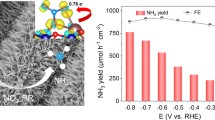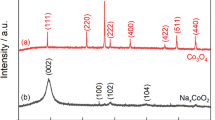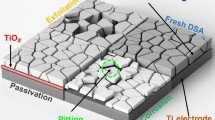Abstract
This work presented the electrochemical study of cerium(III) on the insert electrode (Mo) in NaCl–KCl molten salt in the temperature range 954–1,007 K. The electrochemical methods such as cyclic voltammetry and square wave voltammetry were used for investigating the reduction of Ce(III). The results obtained showed that CeCl3 could be reduced into cerium metal in a quasi-reversible one-step process exchanging three electrons (Ce(III)+3e → Ce(0)) at the operating temperatures on a molybdenum cathode. The diffusion coefficients of Ce(III) ions at different temperatures were determined by cyclic voltammetry. The validity of the Arrhenius law was also verified and the activation energy for diffusion was found to be 46.0 kJ mol−1. The apparent standard potentials of the redox couple (Ce(III)/Ce(0)) at several temperatures was calculated. The thermodynamic properties of cerium trichloride have also been investigated.









Similar content being viewed by others
References
Frederic L, Henri G (2013) In: Frederic L, Burlington HG (eds) Molten salts chemistry from lab to applications. Elsevier Inc, New York, p 3
Hamel C, Chamelot P, Taxil P (2004) Neodymium (III) cathodic processes in molten fluorides. Electrochim Acta 49:4467–4476
Kuznetsov SA, Gaune-Escard M (2001) Redox electrochemistry and formal standard redox potentials of the Eu(III):Eu(II) redox couple in an equimolar mixture of molten NaCl–KCl. Electrochim Acta 46(8):1101–1111
Smolenski V, Novoselova A, Osipenko A, Caravaca C, De Córdoba G (2008) Electrochemistry of ytterbium (III) in molten alkali metal chlorides. Electrochim Acta 54(2):382–387
Vandarkuzhali S, Gogoi N, Ghosh S, Prabhakara Reddy B, Nagarajan K (2012) Electrochemical behaviour of LaCl3 at tungsten and aluminium cathodes in LiCl–KCl eutectic melt. Electrochim Acta 59(1):245–255
Sang-Eun B, Yong JP, Seul KM, Young HC, Kyuseok S (2010) Aluminum assisted electrodeposition of europium in LiCl–KCl molten salt. Electrochim Acta 55(8):3022–3025
Bermejoa MR, Gomeza J, Martlnezb AM, Barradoa E, Castrillejo Y (2008) Electrochemistry of terbium in the eutectic LiCl–KCl. Electrochim Acta 53(16):5106–5112
Virgil C, Anamaria P, Mircea O (2010) Electrochemical studies on cerium(III) in molten fluoride mixtures. J Rare Earth 28(3):428–434
Lin RS, Ye GA, He H, Tang HB, Ouyang YG (2012) Electrochemical behavior of Ce(III) in LiF–BaF2 melts. J Rare Earth 30(2):151–154
Wang CS, Liu Y, He H, Gao FX, Liu LS, Chang SW, Guo JH, Chang L, Ouyang YG (2013) Electrochemical behavior of cerium ion in molten LiCl–KCl. J Rare Earth 31(4):405–409
Inzelt G et al (2013) Handbook of reference electrodes, chapter 7. Reference electrodes for ionic liquids and molten salts Clayton South. Springer, Berlin
Osamu S, Takayuki N, Akihiro U, Hajimu Y (2008) Electrochemical properties of the Ag+|Ag and other reference electrodes in the LiCl–KCl eutectic melts. J Alloys Compd 456(1,2):498–502
Li GX, Zhang SL, Qiao ZY, Wu SM, Yao DK, Wang WS (1983) A Ag/AgCl reference electrode with a long periodic stability for use in LiCl–KCl–NaCl molten salt system. Acad J Steel Acad (in China.) 4(1):97–103
Tang H, Pesic B (2014) Electrochemical behavior of LaCl3 and morphology of La deposit on molybdenum substrate in molten LiCl–KCl eutectic salt. Electrochim Acta 119(10):120–130
Zhang JS (2014) Electrochemistry of actinides and fission products in molten salts-data review. J Nucl Mater 447(1–3):271–284
Martinot L, Bohet J, Duyckaerts G, Muller W (1975) Thermodynamic properties of dilute solution of ThCl4 in (Li–K)Cl and(Na–K)Cl eutectics. J Inorg Nucl Chem 37(7):315–319
Srinivasan R, Flengas SN (1964) Electrode potentials of thorium tetrachloride in alkali chloride melts. Can J Chem 42(6):1315–1322
Delahay (1954) New instrumental methods in electrochemistry. Interscience Publishers, New York
Lizuka M (1998) Diffusion coefficients of cerium and gadolinium in molten LiCl–KCl. J Electrochem Soc 145(1):84–88
Acknowledgments
This work was supported by grants from the National Natural Science Foundation of China (contract Grant Number 91226201).
Author information
Authors and Affiliations
Corresponding author
Rights and permissions
About this article
Cite this article
Jia, YH., He, H., Lin, RH. et al. Electrochemical behavior of cerium(III) in NaCl–KCl molten salt. J Radioanal Nucl Chem 303, 1763–1770 (2015). https://doi.org/10.1007/s10967-014-3723-8
Received:
Published:
Issue Date:
DOI: https://doi.org/10.1007/s10967-014-3723-8




